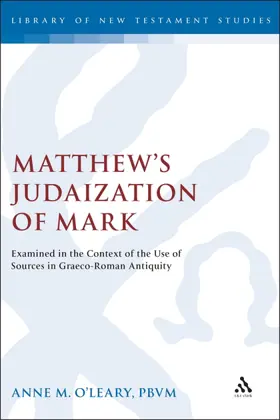

Matthew's Judaization of Mark: Examined in the Context of the Use of Sources in Graeco-Roman Antiquity
in Library of New Testament Studies
Pages
240
Publisher
T&T Clark
Published
11/23/2006
ISBN-13
9780567031044
Creative imitation (Gk., mimesis; Lt., imitatio) was the primary literary convention of the ancient world of the first century CE. In the first part of the book it is demonstrated that it was the principal means by which classical authors, for example, Virgil, Seneca, Plutarch, and Livy, composed their works. An examination of the use of sources in both Jewish and Christian Sacred Scriptures in the light of this convention provides a new and fruitful approach to scripture scholarship. The Book of Tobit and Paul's First Letter to the Corinthians (1 Cor 8-10) are examined to demonstrate this thesis. This sets the context for an examination of Matthew's use of Mark as a literary source in the light of Graeco-Roman literary conventions in part two of the book. Such a use is entirely plausible when one considers that, "penned in Greek, probably to Diaspora audiences, the canonical gospels reflect Greco-Roman rather than strictly Palestinian Jewish literary conventions." Both the way in which Matthew incorporates his Markan source into his text, and the function and effect of this source in its new Matthean context are examined. This methodology provides compelling evidence that Matthew's use of Mark as a source was toward the Judaization of his Gospel.
- Table of Contents
- Preface
- Abbreviations
- List Of Abbreviations
- Introduction
- Part 1: Use Of Sources In Graeco-Roman Antiquity: Towards A Context And Criteria For Examining Matthew's Use Of Mark As A Source
- Chapter 1. Use of Sources in Graeco-Roman Antiquity
- The Context: Widespread Practice of Literary Borrowing
- The Theory and Practice of Rewriting
- Criteria for Establishing Literary Dependence
- Conclusion
- Chapter 2. Rewriting: Evidence from Graeco-Roman Texts
- Virgil's Use of Homer's Iliad and Odyssey, and Apollonius' Argonautica as Sources Seneca's Use of Euripides' Hippolytus and Bacchae, Virgil's Aeneid, and Ovid's
- Heriodes and Metamorphoses as Sources
- Historiography and Bioi: Use of Sources by Livy and Plutarch
- Conclusion
- Chapter 3. Rewriting: Evidence from Jewish Texts
- Tobit's Use of Genesis, Deuteronomy and Homer's Odyssey as Sources
- Paul's Use of Torah as a Source in 1 Cor. 8.1-11.1
- Conclusion
- Chapter 1. Use of Sources in Graeco-Roman Antiquity
- Part II: Matthew's Use Of Mark As A Source
- Chapter 4. Matthew's Use of Mark as a Source
- Matthew and Mark: The Same Genre and Sub-Genre
- Matthew Rewrites Mark
- Conclusion
- Chapter 5. Matthew's Judaization of Mark
- Matthew's Restructuring of Mark as Based on Key Numerals of Judaism
- Matthew's Reworking of Mark as Based on Judaism's Torah
- Conclusion
- Chapter 6. Matthew's Torahizing of Mark in Two Key Texts: Matthew 10 And 18
- A Ready Harvest (Mt. 9.35-10.5a // Mk 3.13-14, 16-19a; 6.7-8, 34)
- Becoming 'As the Least' Materially (Mt. 10.5-14 // Mk 6.7-8)
- Becoming 'As the Least' Socially (Mt. 10.17-25 // Mk 13.9-13 and 10.43-44) Becoming 'As the Least' Spiritually (Mt. 10.40-42 // Mk 9.37b, 41)
- The Temple Tithe Issue Deuteronomized (Mt. 17.22-27
- Becoming as a Little Child (Mt. 18.1-10 // Mk 9.34, 36, 37a; 10.15; 9.42a, 43, 45, 47; 14.21, in that order)
- Brotherly Correction Deuteronomized (Mt. 18.15-35)
- Conclusion
- Chapter 4. Matthew's Use of Mark as a Source
- Conclusion
- Bibliography
- Index